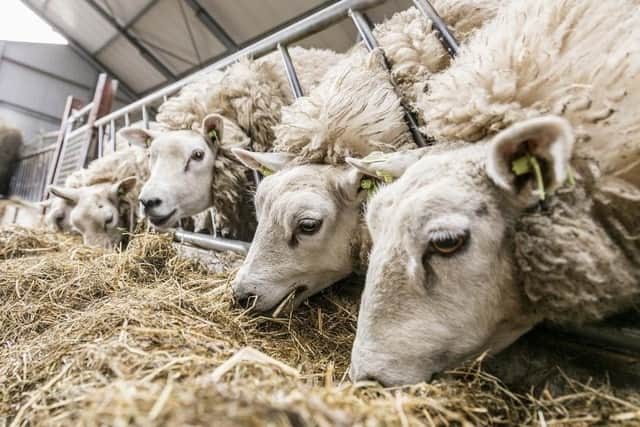Feeding the ewe in late pregnancy
and live on Freeview channel 276
Feeding ewes appropriately, particularly in the last six to seven weeks pre lambing, influences lamb birth weight, lamb vigour, colostrum production, lamb survival and ultimately influencing farm profitability for the year ahead.
In the final six to seven weeks before lambing, approximately 75% of foetal growth occurs.
Advertisement
Advertisement
The ewe’s nutritional requirements also rise rapidly to maintain her own body reserve, to support her growing lambs and to enable her to produce an adequate supply of colostrum and subsequent milk production.


However, as the lambs grow, rumen space is reduced and appetite can be suppressed by 30% making it difficult for the ewe to meet her nutrient demands from forage alone. Therefore, concentrate supplementation is required.
The level of concentrate feeding required for ewes will be determined on the following factors:
Forage quality
As forage is notoriously variable, testing is critical to determine the quality (dry matter, energy, D value and protein values) being fed and therefore how long concentrate supplementation will be required.
Advertisement
Advertisement
In the last three weeks of pregnancy the ewe’s requirement for protein will increase from 100g of protein per day to 200g per day. Protein quality is critically important in the last three weeks of pregnancy for lamb growth, udder development, colostrum production and milk supply in early lactation.
During late pregnancy microbial protein can only meet 60-70% of the ewe’s protein requirements, so there is need for bypass protein in the diet for the last two to three weeks, especially for ewes carrying multiple lambs.
Sources of bypass protein include Soya bean meal and Lactamine. Insufficient protein can decrease colostrum quantity by 50% and colostrum quality by 65%.
Scanning results
Pregnancy scanning should be carried out around 80 days post tupping, this will help identify ewes with higher requirements, and so ensure that these requirements are met and that feeds are used efficiently.
Advertisement
Advertisement
Scan results should be used to group ewes according to litter size and expected date of lambing before starting to feed concentrates.
This will ensure that ewes are in good condition and lambing, have a good milk supply and do not produce over-sized singles and/or under-sized multiple lambs, reducing lambing problems and associated mortality.
Ewe body condition score should also be assessed at scanning, ideally a target BCS at lambing should be a minimum of 3.0 for lowland ewes and 2.5 for hill ewes.
Thin ewes may be supplemented with additional concentrates to gain condition.
Other important factors to consider
Minerals
Advertisement
Advertisement
The supplementation of a good mineral and vitamin premix in the pre-lambing concentrate feed such as Maxcare ewe + Vit E, is also an essential part of the diet to ensure optimal performance.
Ewes require a comprehensive range of trace elements minerals and vitamins pre lambing in particular –
Vitamins E – important for immunity and health and stimulates improved lamb vigour at birth and subsequent growth to weaning.
Supplementation is crucial as levels in conserved forages are generally low.
Selenium- Boosts ewe immunity and health.
Advertisement
Advertisement
It also aids lamb vigour by helping mobilise brown fat at birth and reducing risk of hypothermia.
Cobalt – An important constituent of vitamin B12. Helps lambs to stand and suckle earlier.
Iodine – Very important for foetal development, lamb vigour and control of ewes’ metabolic rate.
Zinc – Helps limit mastitis and improve hoof health.
Water
A fresh clean water supply is always critical for pregnant ewes.
Advertisement
Advertisement
A pregnant ewe can consume up to six litres of water per day and up to eight to 10 litres during lactation.
Water troughs should be checked and cleaned out on a regular basis, to avoid contamination. Additionally, checks should be taken in frosty weather to ensure constant water supply.